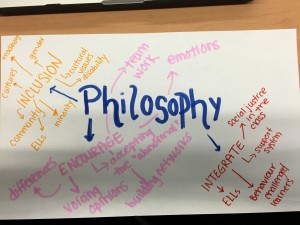Barker, Frederik’s, and Farrelly indicate that teacher reflections is a key component for an educator in order to critically analyze their approach to an inclusive classroom. They provided a range of question educators an reflect on. However, I question this notion of reflection. In my process of becoming an educator reflecting on my strategies, work and approaches becomes like a checklist.
For example, what do I know about the cultural, linguistic, religious and educational backgrounds of my students and other staff? To be completely honest, looking at the time constraint and the number of students in my class I would feel very over whelmed to make such an effort, hence the idea of a checklist. I know this is very important connection I have to make with my students as this is a key component of my classroom climate. Instead of getting this information through a conversation I would somehow do it in an activity or in a creative way. Once I do make such a connection with my student who will tell me if I have done it properly. My self-evaluation would be excellent as I would have some tangible work that shows I know the culture views of my students. How do I know I got this information the correct way? How do I know the information I got is authentic?
Since I am not able to answer these questions I do not know if self reflection would be a sufficient way for me to know to assess my approach.
A strategy, which is suggested by Barker, Frederik’s, and Farrelly for teachers to create an inclusive classroom and being culturally aware, is to pronounce a students name correctly. By doing this it shows the student that the teacher respects his or her culture. I agree a student name should be produced properly, however, does that mean a teacher is not culturally aware? If a teacher can pronounce a name does that mean he or she has to be any other effort into inquiring?
For example, sometimes when I observe my SA there are certain things that I would approach differently, however, in her learning process this is the best approach for her. Is it appropriate to criticize a colleague? Is there a structured body of individuals that can monitor this?
